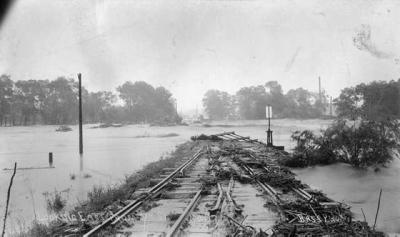
 |
|
||
 Flood of 1894 from 7th Street looking east. Copyright by the Denver Public Library. Visit the BASIN Gallery for more information. |
|
| Because Boulder is situated at the base of the mountains, there is an
ever-present threat of flood, particularly when spring rains or cloud
bursts combine with melting snow from the mountains. (Flooding may occur
with or without the addition of melting mountain snow in the creeks and
is therefore not limited to the spring runoff.) Creeks can quickly turn
into raging rivers, especially if they are already swollen from melting
snow. It's important to note that though the plains are considered semi-arid,
the Continental Divide receives 40" of moisture per year, mostly in snow.
Floods have always been a part of Boulder's history. Floods have been recorded every few years, and a 100-year flood occurred in 1894. (A 100-year flood means that there is a 1% chance of a major flood with a peak discharge of 12,000 cubic feet per second in any given year. Approximately 1/4 to 1/3 of Boulder would be effected by flood waters of this magnitude.) In that year upslope conditions brought rain that lasted 60 hours. The snow pack began to melt. The following is one witness' account of the flood:
Rather than institute severe structural changes in Boulder Creek and the other creeks flowing into Boulder, the city decided to work with nature and to respect the ecology of the creeks. Bridges were modified and replaced to accommodate peak flood flows. Areas near the creeks were constructed to contain flood waters and to divert them away from homes and businesses. Stricter building requirements in the flood plain were implemented. Today there are fifty-three stream and rain gauges located in the canyons of the nine drainage areas entering into Boulder. These gauges monitor rainfall and measure water level changes in the creeks. Information is automatically entered into computers operated by the City and County of Boulder. Should a dangerous level occur, sirens will sound throughout the city and at the University of Colorado signaling flood danger. There is no warning system in the canyons. How much warning time would there be? Not much, according to Larry Stern, director of the Office for Emergency Management. In the event of a l00-year flood we would have perhaps a 40-minute warning before a ten-foot wall of water rushed from the canyon into Boulder. What to do in case of a flood? Get to high ground fast. What you should
not do is to try to outrun the flood in your car. Many people are killed
by floods when trying to reach safety by car. "Climb high or die" is
the best advice for flash floods. BE SURE TO CHECK OUT HISTORY OF FLOODING IN BASIN HISTORY BEYOND BASIN |